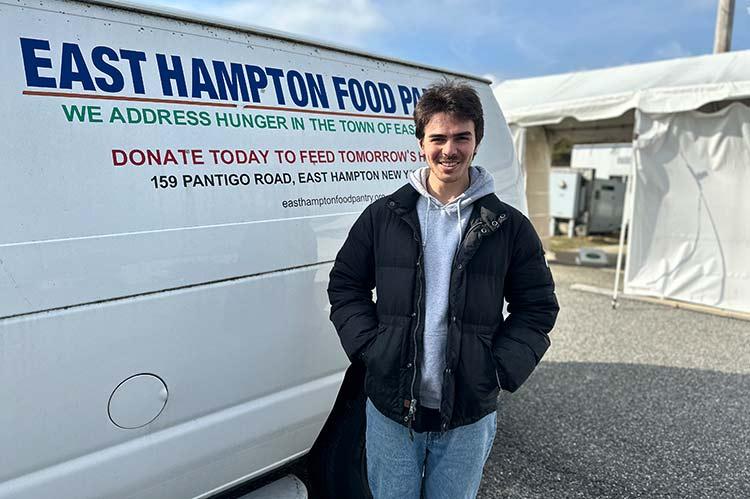Noah Gualtieri may be new to the job of operations manager at the East Hampton Food Pantry, but he is hardly new to the work of the pantry.
Mr. Gualtieri was a food pantry volunteer from the age of about 12 all the way through high school, following in the footsteps of his mother, Marguerite Davidowicz, who is on the nonprofit’s board. “My mom had always volunteered at the Amagansett Food Pantry,” he said on a Thursday afternoon earlier this month. In high school, he lent a hand nearly every Tuesday, often convincing his friends to join him. “It was always fun.”
When his mother mentioned that the pantry was looking for a full-time operations manager, it was a no-brainer for him to apply.
Newly graduated from the Maryland Institute College of Art in Baltimore, where he studied printmaking and graphic design, he started with the food pantry between Thanksgiving and Christmas, its busiest season of year. “It was a crazy time to start,” he said.
Food pantry distribution takes place weekly on Tuesdays from 1 to 6 p.m., “but if the line is long, we’re not going to turn anyone away,” Mr. Gualtieri said. On Wednesdays, food is delivered to people who cannot come in person to the distribution site, which is behind Town Hall.
As operations manager, his job, in part, is making sure there will be enough food for everyone who needs it on Tuesdays and Wednesdays. When the bagging area is nearly empty the day after distribution and delivery, it can be a daunting task. “Last week we served over 800 people,” he said on Feb. 1.
The pantry operates solely on donations and spends roughly $30,000 a month to supplement the donated foodstuffs it receives, according to Kitty Merrill, its administrator. The need appears to be growing. For the week of Jan. 8, the pantry served 249 families, or 760 individuals, up from 177 families, or 459 individuals, in the same week last year. That number jumped to 800 individuals the week of Jan. 22 of this year, and 825 the week of Jan. 29.
The pantry works directly with distributors to buy or secure fruit, vegetables, meat, cheese, eggs, and milk for its clients. The distributors offer favorable prices and are valuable partners in the effort. That is why monetary donations are so important. Food also comes to the pantry through East End farmers and agencies like Long Island Cares and Island Harvest.
Some of the nonperishables come from donation boxes or food drives at libraries or schools. “The food donation boxes add up to a lot,” Mr. Gualtieri said. “A lot of my week is checking expiration dates on donated food. A lot of people, though their intentions are good, give us their garbage.” Later he added, “Please check the expiration dates on the food you give us.”
A larger trailer near the food pantry office is filled with dry goods. The perishable items generally arrive the morning of distribution.
Each week, families get a grocery bag filled with dry goods, portioned according to the size of the family. Mr. Gualtieri tries to vary the contents from week to week and to keep track of individual families’ requests. Some need diapers and baby formula, some hope for pet food for a dog or cat. One week the bag might include a bottle of ketchup, but every week there are basics like canned or dried beans, rice, pasta, canned fruits or vegetables, broth or soup.
The perishables are divided according to family size, too, with different weights of hamburger meat or chicken, for example, or a full or half-dozen eggs. “We keep track of how many people are in a family and their ages.”
Every Tuesday, the pantry has six to eight volunteers on hand. “Without the help of volunteers, our lives would be 10 times harder.” They are a tight-knit group, he said, and “everyone is so nice so they turn everything that’s hard work into fun.”
Volunteers are needed every day of the week, Mr. Gualtieri said, but “Tuesdays, that’s when the real fun is.” Would-be helpers can call the pantry office to get on the schedule.
Monetary donations can be made online at bit.ly/3HYyEFX.




